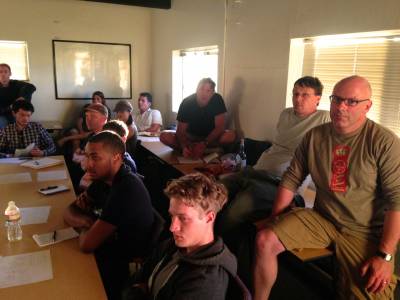Most senior dinghy tests involve assessing the skipper's ability to single hand a dinghy in high winds. And indeed, this is an essential skill. Imagine that you're out in the South Sailing Basin on a beautiful summer afternoon. It's blowing 15 knots, and you and your crew are hiked out all the way when suddenly the hiking strap breaks, and your crew ends up in the drink. (See e.g. http://youtu.be/ZZTwH8C5bjo for an excellent demonstration by our current Commodore). If you can't pull off a single-handed crew overboard maneuver, your crew will end up on the rocks by Emeryville while you wait for the rescue skiff to arrive.
Here are a couple of pointers which will help you single-hand like a pro.
Depowering the sails. Unless you have the stature of an NFL linebacker, chances are that you will have difficulty keeping the boat flat unless you take some steps to depower the sails. Reefing the main and furling the jib are good starting points. Tightening up the luff of the sail with the Cunningham and/or reefing line will help to flatten the sail, reducing its heeling force. Loosening up the vang or gnav will allow the head of the mainsail to twist and luff, all the while keeping the bottom of the sail powered up.
Balancing the boat. Balance is always key in sailing. Since you no longer have crew in the boat, you'll have to use your own weight much more effectively. Moving forward is essential; otherwise, the bow of the boat gets battered around by waves. Aggressively hiking out will help keep the boat flat. If you're lucky enough to be wearing a harness and your tiller extension is long enough, you can even go out on the trapeze!
Tacking and jibing. Tacking a dinghy while single-handed in high wind can be quite challenging; large swells crashing against the bow of the boat tend to slow the boat before it passes through irons, causing the tack to fail. Furling the jib and loosening the vang as suggested above compound the problem, as the boat no longer points as high. In some situations, jibing the boat is the only viable option for switching tacks. For this, loosen up the vang (if this wasn't already done), and start the jibe with a maximal amount of boat speed. You'll have to aggressively use your weight and the tiller to keep the dinghy from rounding up and broaching.





